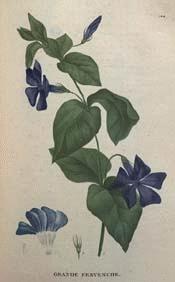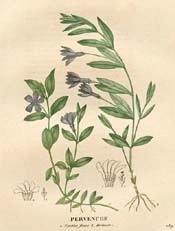
Botanical.com Home Page
PeriwinklesFamily: N.O. Apocynaceae
This is the species more generally used in herbal medicine, as an astringent and tonic, in menorrhagia and in haemorrhages, also as a laxative, and gargle. Made into an ointment, useful for piles and inflammatory conditions of the skin.
Employed in homoeopathy for preparation of a tincture used for haemorrhages. MADAGASCAR PERIWINKLE (Vinca rosea, Linn.) A reputed cure for diabetes. (Synonym Lochnera rosea, Reichb.) The well-known Periwinkles - both Greater and Lesser - familiar plants of our woods and gardens, are members of the genus Vinca, so named by Linnaeus, which includes five in Europe, and the Orient, and three species native to the East Indies, Madagascar and America, assigned by a later botanist, Reichberg, to a separate genus, Lochnera, as they differ from Vinca in the stamens and head of the style not being hairy, though the main characteristics are the same. Vinca is a genus of the natural order Apocynaceae, which includes many tropical trees and shrubs with showy flowers, a large number of which are very poisonous, among these being the beautiful Oleander, so frequently grown in our greenhouses. The Periwinkles are the only representatives of their order in our flora, and there is, in fact, considerable doubt among botanists whether the Periwinkle should be considered a true native of Great Britain. It was a familiar flower in the days of Chaucer, who refers to it as the 'fresh Pervinke rich of hew,' and it is now commonly found in woods and hedgerows, and, where it occurs, is generally in great profusion. The plant is perennial and retains its glossy leaves throughout the winter. Occasionally, in the smaller kind, when cultivated in gardens, leaves occur with streaks of lighter green upon the dark rich colour that is characteristic of the rest of the foliage. The leaves are always placed in pairs on the stem, the flowers springing from their axils. In the Greater Periwinkle, the leaves are large and egg-shaped, with the margins minutely fringed. Those of the Lesser are much smaller, myrtle-like in form, their margins not fringed. The plant seldom, if ever, ripens its seed, a fact that has been considered confirmatory of the theory that the Periwinkle is not truly indigenous, as in more southern countries it does so. It propagates itself by long, trailing and rooting stems, and by their means not only extends itself in every direction, but succeeds in obtaining an almost exclusive possession of the soil, since little or nothing else can maintain its ground against the dense mass of stems, which deprive other and weaker plants of light and air. The flowers of the Periwinkle vary somewhat in intensity of colour, but the average colour is a deep purplish-blue. A white variety of the Lesser Periwinkle occurs in Devonshire and in gardens; it is often met with bearing purple, blue and white flowers, sometimes double. The calyx is deeply cleft into five very narrow divisions. The corolla consists of a distinctly tubular portion terminating in a broad flat disk, composed of five broad lobes, twisted when in bud, curiously irregular in form, having the sides of the margin unequally curved, so that although the effect of the whole corolla is symmetrical, when each separate lobe is examined, it will be seen that an imaginary line from apex to the centre of the flower would divide it into two very unequal portions - very unusual in the petals of a flower. The whole effect is as if the lobes of the corolla were rotating round the mouth of its tube, and the movement had suddenly been arrested. The mouth of the tube is angular and the tube closed with hairs, and the curiously curved anthers of the stamens, which are five in number, are inserted in the tube. The pistil of this flower, as well as of the smaller species, is a singularly beautiful object, resembling the shaft of a pillar with a double capital. The anthers stand above the stigmatic disk, but the stigma itself is on the under surface of the disk, so that selffertilization is not caused as the insect's tongue enters the flowers. The Lesser Periwinkle is not only smaller in all the parts, but has a more trailing habit of growth, matting itself together. The stems are very slender, only those bearing flowers being erect, growing to a height of 6 to 8 inches, the others trailing and rooting freely at intervals, so that a large space of ground is quickly monopolized by it.
[Top]
An old name, given both in reference to its colour and its use in magic, was 'Sorcerer's Violet' (corresponding to its old French name 'Violette des sorciers'). It was a favourite flower with 'wise folk' for making charms and love-philtres. It was one of the plants believed to have power to exorcize evil spirits. In Macer's Herbal we read of its potency against 'wykked spirytis.'
The flower is called by the Italians Centocchio, or 'Hundred Eyes,' but it is also called 'The Flower of Death,' from the ancient custom of making it into garlands to place on the biers of dead children. To the Germans, it is the 'Flower of Immortality.' In France, the Periwinkle is considered an emblem of friendship, probably in allusion to Rousseau's recollection of his friend Madame de Warens, after a lapse of thirty years, by the sight of the Periwinkle in flower. [Top] ---Uses---Both species of Periwinkle are used in medicine for their acrid, astringent and tonic properties.
Vinca major is used in herbal practice for its astringent and tonic properties in menorrhagia and in haemorrhages generally. For obstructions of mucus in the intestines and lungs, diarrhoea, congestions, haemorrhages, etc., Periwinkle Tea is a good remedy. In cases of scurvy and for relaxed sore throat and inflamed tonsils, it may also be used as a gargle. For bleeding piles, it may be applied externally, as well as taken internally.
The bruised leaves put into the nostrils will, it is asserted, allay bleeding from the nose. A still more important use has been found for another species, V. rosea, Linn. (synonym Lochnera rosea, Reichb.), sometimes known as the Madagascar Periwinkle, a small undershrub up to 3 feet high in its native habitat, the general appearance much resembling our English species, V. major, but with the stems more upright. It is widely spread in Tropical Africa and naturalized in the Tropics in general. It is not sufficiently hardy to stand our climate without protection, though it is often grown in conservatories in this country. The blossoms are a rich crimson. In 1923, considerable interest was aroused in the medical world by the statement that this species of Vinca had the power to cure diabetes, and would probably prove an efficient substitute for Insulin, but V. major has long been used by herbalists for this purpose. ---Preparation---Fluid extract. [Top]
© Copyright Protected 1995-2025 Botanical.com
|

